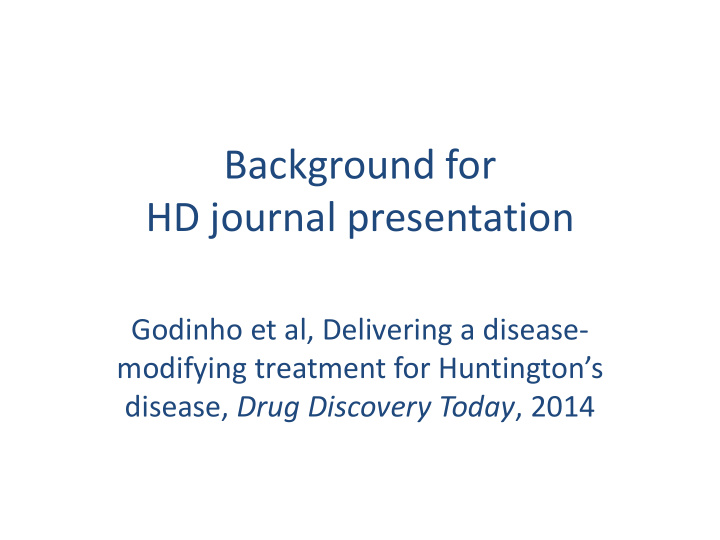



Background for HD journal presentation Godinho et al, Delivering a disease- modifying treatment for Huntington’s disease, Drug Discovery Today , 2014
Abstract
The human HTT gene and protein
RNA interference (RNAi): short hairpin (SH) RNAs or short interfering (si)RNAs “microRNA” “ mirtron ” shRNAs Pathway Pathway synthetic Pol II Pol II siRNAs “Micro - processor Complex” RNA editing (not shown) “Passenger” strand “Guide” strand RISC complex argonaute (Ago) Pol II = RNA polymerase II; pri-miRNA = primary miRNA; Note: some pri-miRNAs generated by pol III; Pasha = DGCR8 (DiGeorge syndrome critical region 8); Drosha = RNase III activity-containing protein ; Pre-miRNA = precursor miRNA; Dicer = RNAase III enzyme; RISC = RNA-induced silencing complex; RITS = RNA induced transcriptional silencing
Antisense oligonucleotides (ASOs) PNA = peptide nucleic acid Morpholino: morpholine ring replaces ribose ring; phosphorodiamidate groups replace phosphate groups
Ribozymes
DNA enzymes Schlosser K and Li Yingfu, Biologically inspired synthetic enzymes made from DNA, Chemistry and Biology 16 , 311-322, 2009
Genome editing: repair of double-stranded DNA breaks
Genome editing: Zinc finger nucleases (ZFNs) Fok I restriction endonuclease Carroll D, Genome Engineering with Zinc-finger nucleases, Genetics 188 , 2011
Genome editing: Transcription activator-like nucleases (TALENs) Each 34-amino acid repeat recognizes one base pair in double-stranded DNA NTF3 = neurotrophin 3; CCR5 = chemokine C-C motif receptor 5 Boch J, 2011
Genome editing: Clustered regulatory interspaces short palindromic repeat (CRISPR-Cas9) systems Jennifer Doudna, Ph.D. Emmanuelle Charpentier, Ph.D. Professor of Chemistry and Department Head: Regulation in Molecular and Cell Biology Infection Biology, Helmholtz at the University of California, Centre for Infection Research, Berkeley Professor, Hannover Medical School CRISPR-Cas9 RCas9
Technical and ethical issues: 1. Off target effects 2. Efficient delivery to cells and tissues (e.g. adeno-associated virus (AAV)-based; lipid-formulated siRNAs; nanoparticles) 3. Use for the modification of plants and animals 4. Use to treat or prevent human genetic diseases
Recent internet headlines: (Received $3,000,000 USD!)
References 1. Godinho B, et al, Delivering a disease- modifying treatment for Huntington’s disease, Drug Discovery Today 20, 50-64, 2015 2. Gupta RM and Musunuru K, Expanding the genetic editing tool kit: ZFNs, TALENs, and CRISPER-Cas9 , Journal Clinical Investigations 124 , 4154-4161, 2014 3. Carroll D, Genome Engineering with zinc-finger nucleases, Genetics 188 , 773-382, 2011 4. Miller JC, et al. A TALE nuclease architecture for efficient genome editing, Nature Biotechnology 29 , 143-148, 2011
Recommend
More recommend